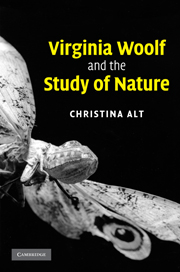Book contents
- Frontmatter
- Contents
- Acknowledgements
- List of abbreviations
- Introduction
- 1 The natural history tradition
- 2 The modern life sciences
- 3 ‘To pin through the body with a name’: Virginia Woolf and the taxonomic tradition
- 4 Laboratory coats and field-glasses: Virginia Woolf and the modern study of nature
- 5 Representing ‘the manner of our seeing’: Literary experimentation and scientific analogy
- Notes
- Bibliography
- Index
3 - ‘To pin through the body with a name’: Virginia Woolf and the taxonomic tradition
Published online by Cambridge University Press: 04 August 2010
- Frontmatter
- Contents
- Acknowledgements
- List of abbreviations
- Introduction
- 1 The natural history tradition
- 2 The modern life sciences
- 3 ‘To pin through the body with a name’: Virginia Woolf and the taxonomic tradition
- 4 Laboratory coats and field-glasses: Virginia Woolf and the modern study of nature
- 5 Representing ‘the manner of our seeing’: Literary experimentation and scientific analogy
- Notes
- Bibliography
- Index
Summary
In the midst of the many changes occurring in the late nineteenth- and early twentieth-century life sciences, the one constant was the tendency among modern practitioners of the life sciences to define their emerging disciplines against the taxonomic tradition of natural history. In her use of natural history as a subject and a symbol, Woolf was equally consistent. Woolf's childhood encounter with natural history led her early in life to form a critical view of the taxonomic tradition and its component practices of collection and classification. Thereafter, she repeatedly employed the collecting habit and the classificatory mentality as analogies through which to comment on social and literary conventions that she regarded as similarly restrictive and reductive. Through a review of Woolf's childhood responses to the natural history tradition, this chapter outlines the way in which she arrived at her conception of the pastime; it then surveys her use of natural history and its component practices as stable points of reference in her fiction. Because Woolf's views of taxonomic natural history were established early and varied little over the course of her life, her use of this imagery forms a coherent argument running through her work and linking together a range of practices and attitudes that she wished to interrogate.
THE ORIGINS OF WOOLF'S RESPONSE TO TAXONOMIC NATURAL HISTORY
Looking back on the earliest days of her participation in natural history, Woolf recalls the pastime as an obsession shared with her siblings, ‘our mania’, and in the Hyde Park Gate News, the Stephen children show themselves to be ‘enthusiastic butterfly collectors’ (MOB 113; HPGN 121).
- Type
- Chapter
- Information
- Virginia Woolf and the Study of Nature , pp. 72 - 105Publisher: Cambridge University PressPrint publication year: 2010



